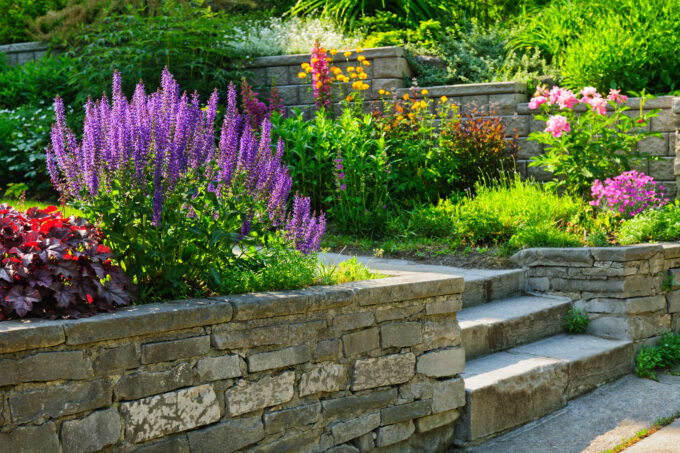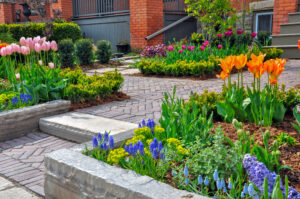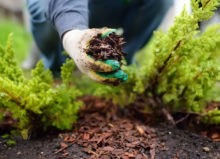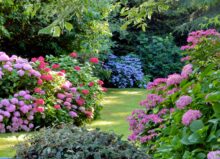The Power of Using Color in Landscape Design

Why do some landscapes make us turn our heads and look twice? How are they different from those we barely notice? Quite often, the answer is in the use of color. When a lawn or garden pops with color, the land and everything on it becomes more appealing.
Color can draw the eye to a specific part of a garden, create a mood that transitions naturally from one season to the next, and attract birds and butterflies.
Even though color can do so much for a landscape, it can be difficult to pull off successfully.
So, how do you use color correctly in a landscape design?
Understanding Color
A beautiful, colorful landscape may look like magic, but it isn’t. There are some basic color principles that landscape designers employ to get the most out of color.
Primary, Secondary, & Tertiary Colors
Color theory starts with the primary colors: blue, red, and yellow. Next are the secondary colors created by combining the primaries: purple from blue and red, green from blue and yellow, and orange from yellow and red. Beyond that, tertiary colors are produced by mixing a primary with a secondary: yellow-orange, red-orange, etc.
Complementary & Analogous Colors
Colors are often depicted on a color wheel, with blue, red, and yellow at three points and their most strongly related colors close to them. Colors opposite on the wheel are complementary—they bring out the intensity in each other. Colors close together are analogous. When they’re used together, they look like gradations of a single color.
Warm & Cool Colors
Colors also have personalities that are warm or cool. Red, yellow, and orange are warm colors, while blue, purple, and pink are cool ones. Warm colors lend energy and excitement. Cool colors are calming and tend to recede into the background. An advantage of cool colors is that they make a space look larger, a useful characteristic in small yards. Balanced landscape designs use both warm and cool colors.
Tips for Using Color Effectively in Landscaping

There are so many colors in nature and options for colorful landscaping that it might be hard to know which to choose. Here are a few tips to set you on your way:
- Start with colors you like! After all, it’s your garden, and the more it fits your personality and taste, the more enthusiastic you’ll be about making it great.
- Use both warm and cool colors. In most gardens, the cool will outnumber the warm.
- Pair primaries with their opposites on the color wheel: red with green, blue with orange, yellow with purple.
- Don’t use too many colors. A garden with only a few colors looks more composed.
- Use monochrome (one primary color scheme) and analogous cool colors as background. For example, multiple shades of the blue-to-purple family make an attractive background for splashes of yellow and orange. White is versatile because it complements every color.
- Use containers. You might have alternating warm and cool colors in a long container, or a square container could feature one or two central warm flowers surrounded by cool colors.
- Group plants with similar watering needs. This is particularly important in containers, which usually get watered on an all-or-nothing basis.
- Balance colors across your landscape. If you have separate gardens, distribute the warm colors so there are roughly equal amounts of warm colors in each section.
- Rocks and mulch can have color, too. Use them to match or complement your flowers.
- Don’t forget pattern, texture, and height. Use variegated leaves in groupings. Distribute tall and short plants across your landscape. Take advantage of the contrast between full and airy plants.
Seasonal Considerations
Some flowers start early and bloom all season, while some are done by midsummer. There are even flowers that don’t hit their stride until later in the year. If you want a landscape that’s interesting year-round:
- Intermix flowers that bloom best at different times of the season.
- Use foliage to create attractive spaces even when they’re not blooming.
- Consider how your landscape will look in winter. Some large annuals and perennials have stalks that provide structure standing in the snow after the flowers are long faded. Also, evergreen trees and shrubs will anchor a winter scene.
Create a Vibrant, Colorful Landscape With Help From Design One
Creating the right landscape design can be challenging. If you don’t know where to begin, let our team at Design One help you.
For over 30 years, we’ve provided licensed, insured, and certified landscape design and installation services to homeowners and businesses in Michigan. Contact us today to schedule a project consultation and learn how we can help you transform your landscape.
As a residential and commercial landscaping company in Michigan, we’re experienced in both property care and landscaping design. With over 40 years of experience in the industry, Design One is great source of information when it comes to your Michigan lawn care needs! From preliminary design mapping, to irrigation and the types of plants you might want on your priority, we cover it all.





